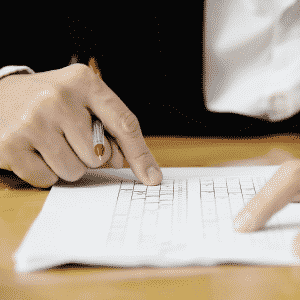It is always best to have a second set of eyes look at anything you write before it goes out to the public. Knowing how to proofread other people’s copy – and even your own – is an important skill.

As an experienced editor and proofreader, the most important piece of advice I can give to people about proofreading their own work is: DON’T!
It is always best to have a second set of eyes look at anything you write before it goes out to the public. And yes, I do heed my own advice. Even with all my experience, I know that it can be very difficult to spot every mistake – and we all make them! – in my own copy. I always try to have someone else proofread anything I write.
If what you are writing will reflect on the reputation of your business, or yourself, it is vitally important it is checked before you publish – especially if you are not 100% confident in your spelling, grammar, and punctuation skills (do you know the difference between your and you’re, or why ‘sneak peak’ is wrong?).
Even small spelling errors in advertising, social media posts or newsletters can dent your reputation. And a major error, even if it’s a common one (i.e., ‘sneak peak’), reflects poorly on your professionalism and attention to detail.
It’s best to have a professional editor or proofreader review your copy.
Of course, sometimes we need to publish quickly. Or, even if we are sending our copy to someone to check, the fewer errors they need to correct means the fewer they risk missing. When a proofreader is making a lot of corrections, it is very easy to inadvertently overlook one or two.
So, knowing how to proofread your own work is still an important skill to have.
Here are our top 10 tips to improve your proofreading.

Take your time
Many people will have seen those passages in which numerals replace letters, or words have the correct first and last letter but the rest is a jumble, yet the sentence can still be read and understood. That is because in many cases our brains are already anticipating the next word – which makes it very easy to see what we expect and overlook an error. When you are proofreading, do it slowly and carefully.
Get your ears and eyes working together
Reading out loud – slowly and deliberately, ensuring you properly enunciate each word – is a great way to help you identify any errors.
Look at it a different way
If you have been reading on a screen, print it out. Or change the font and colour. Changing how we look at text gives our eyes and brains a bit of a shake-up and makes us look more carefully at the words. When they don’t appear quite the same as what we have been reading for hours, we are more likely to see any errors.
Read it backwards
Given our brains can often anticipate the next word in a sentence, reading it backwards can help us identify spelling errors.
Take a break
When staring at the same words over and over, you are less likely to spot mistakes. Take a break to rest your eyes and brain before giving it another check.

Look at each element
Similar to reading backwards to focus on each word, this time ignore the words and just look at the punctuation. In longer documents, go back and check page numbering, or consistent style in things such as dates or section heads, graphics, etc. It is much easier to focus on one element at a time.
Use a spelling and grammar checker
Spelling and grammar aids that come standard with word processing programs, such as Microsoft Word spellchecker, or an online program such as Grammarly, can be a great help in your writing and proofreading. Just remember you might need to adjust your settings – if you are writing for an Australian audience, you will want to use spellings such as ‘harbour’ and ‘harmonise’, not ‘harbor’ and ‘harmonize’.
Know your ABCs
If you are reading your own copy, it really does help if you know how to spell and understand basic grammar and punction rules. There’s little point checking for errors if you don’t know the difference between ‘your’ and ‘you’re’.
Also make sure you understand what you are reading, especially if using idioms or common sayings. ‘Sneak peak’ is an error that often pops up in sales posts. But a ‘peak’ is a high point, such as a mountain. Getting a sneaky first look at something before anyone else is a ‘sneak peek’.

Keep a dictionary (even an online one) handy!
If you are not sure how to spell something, look it up. If your spellcheck tool suggests more than one option, confirm which one is correct. In Australia, your go-to should be the Macquarie Dictionary.
Get help if you need it
If you are someone who does struggle with spelling and grammar (and that’s OK, I struggle with lots of other things), then you should consider hiring a professional editor. Maybe even a writer. TCC International offers a range of writing, editing and design services, for everything from social media posts, blogs and websites to annual reports and book editing and proofing.

